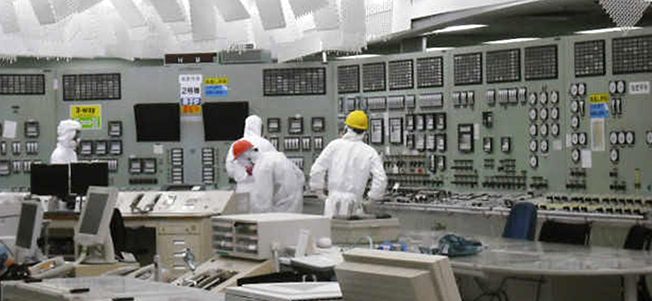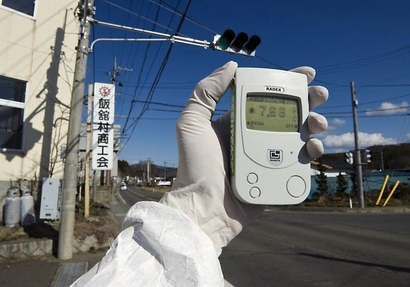Just an update on the struggle to bring the Fukushima nuclear plants in line. I believe that Japan can conquer this crisis, but I am concerned about the governments insistence that the radiation level readings are exaggerated. Beaurocratic tape usually tries to cover up mistakes. Momma Cha
Japan’s PM Vows To Win Battle Against Nuke Plant
Reuters/Air Photo Service
An aerial view of the Fukushima Daiichi Nuclear Power Station.

AP – In this Thursday, March 24, 2011, photo available Friday, April 1, 2011, inside of the Unit 4 at the
Fukushima plant.
… By RYAN NAKASHIMA and MARI YAMAGUCHI, Associated Press Ryan Nakashima And Mari Yamaguchi, Associated Press – 1 hr 24 mins ago
TOKYO – Japan’s prime minister sounded a resolute note Friday, promising to win the battle against an overheating nuclear plant even as atomic safety officials raised questions about the accuracy of radiation measurements at the complex.
Naoto Kan was grave a week ago when he addressed this nation rattled by fears of radiation that has contaminated food, milk and tap water. But three weeks after a massive tsunami disabled a nuclear power plant’s cooling systems, Kan vowed that Japan would create the safest system anywhere.
Japan will “do whatever it takes to win the battle” at Fukushima Dai-ichi, Kan said in a televised news conference. And when the crisis ends, “We will establish a system that could respond to any situation based on an assumption that anything could happen.”
While a massive earthquake and tsunami set off a series of events that disabled the plant, the accident has been exacerbated by several missteps along the way. Apparently spotting another mistake Friday, the nuclear safety agency ordered Tokyo Electric Power Co. to review its recent radiation figures, saying they seemed suspiciously high.
TEPCO has repeatedly been forced to retract such figures, eroding confidence in the company’s ability to respond effectively to the crisis and fueling fears over health risks.
Among the measurements called into question was one from Thursday that TEPCO said showed groundwater under one of the reactors contained iodine concentrations that were 10,000 times the government’s standard for the plant, the safety agency’s spokesman Hidehiko Nishiyama said. Seawater and air concentrations from this week also are under review.
“We have suspected their isotope analysis, and we will wait for the new results,” Nishiyama said.
TEPCO has conceded that there appears to be an error in the computer program used to analyze the data, but spokesman Junichi Matsumoto insisted that the glitch only affected readings for two radioactive isotopes, neither of which was iodine or other readings that have raised recent radiation concerns.
The Nuclear and Industrial Safety Agency has held out the possibility that a complete review of all radiation data collected since the tsunami might eventually be ordered.
In any case, it appears radiation is still streaming out of the plant, underscoring TEPCO’s inability to get it under control. The company has increasingly asked for international help in its uphill battle, most recently ordering giant pumps from the U.S. that were to arrive later this month to spray water on the reactors.
AP/Japan Defense Ministry
Though experts have said radiation seeping into the ground under the plant is unlikely to reach drinking supplies, there are two ways that could happen.
One is if it were to seep into wells in the area. For now, a 12-mile (20-kilometer) radius around the plant has been cleared, though residents of the area are growing increasingly frustrated with evacuation orders and have been sneaking back to check on their homes.
Chief Cabinet Secretary Yukio Edano cautioned on Friday that there were no plans to lift the evacuation order anytime soon.
“Unfortunately this is likely to be long,” he told a news conference. “I think we’re in a situation where it’s not the time to release the evacuation order in a few days or a few weeks.”
The other concern is that contaminated water from the plant could eventually make its way into rivers used for drinking water. Tomohiro Mogamiya, an official with the Ministry of Health, Labor and Welfare’s water supply division, said that was “extremely unlikely” since groundwater would flow toward the ocean, and the plant is right on the coast.
The two closest filtration plants for drinking water have both been shut down because they are just inside the exclusion zone.
“When people return to the area we will test the water to make sure it is safe,” said Masato Ishikawa, an official with Fukushima prefecture’s food and sanitation division.
Radiation concerns have rattled the Japanese public, already struggling to return to normal life after the earthquake-generated tsunami pulverized hundreds of miles (kilometers) of the northeastern coast. Three weeks after the disaster in one of the most connected countries in the world, 260,000 households still do not have running water and 170,000 do not have electricity. Officials fear up to 25,000 people may have been killed.
In the latest report of food becoming tainted, the government said Friday that a cow slaughtered for beef had slightly elevated levels of cesium, another radioactive particle. Officials stressed that the meat was never put on the market.
Contamination also has affected work at the plant itself, where radioactive water has been pooling, complicating the vital work of powering up the complex’s cooling systems.
Despite the leaks, TEPCO hasn’t had enough dosimeters to provide one for each employee since many were destroyed in the earthquake. Under normal circumstances, the gauges, which measure radiation, would be worn at all times.
Officials said Friday that more meters had arrived and there are now enough for everyone.
“We must ensure safety and health of the workers, but we also face a pressing need to get the work done as quickly as possible,” said nuclear safety agency spokesman Hidehiko Nishiyama. Until now, sharing meters “has been an unavoidable choice.”
TEPCO has repeatedly relaxed safety standards during the crisis in order to prevent frequent violations. That is not uncommon during emergencies.
On Friday, Kan reiterated that the utility would be responsible for compensating victims of the nuclear disaster — a bill that could be anywhere between 1 trillion and 10 trillion yen ($12 billion and $120 billion), depending on how long it takes the utility to resolve the crisis, according to Yusuke Ueda, an analyst with investment bank Merrill Lynch. But the prime minister added that the government will provide some compensation beyond the utility’s legal responsibility.
Though the company has acknowledged that it was initially slow to ask for help in dealing with the nuclear crisis, experts from around the world are now flooding in. And two giant pumps, typically used for spraying concrete, will soon arrive from the U.S. They are being retrofitted to spray water, according to Kelly Blickle, a spokeswoman at Putzmeister America Inc. in Wisconsin. At least one similar pump is already in operation at the plant.
U.S. troops also are involved in the search for the dead. Japan’s defense ministry said that, starting Friday, the two militaries will create joint teams to look for bodies from the air. So far 11,500 people have been confirmed dead. Of those, more than 9,000 have been identified. Another 16,400 are missing, and many may never be found.
Hundreds of thousands more people are living in evacuation centers, some forced to leave their houses near the plant because of radiation concerns.
Some residents are growing angry and frustrated with the government and are increasingly violating the bans to return to their homes to gather whatever they can find.
“There is no doubt in my mind that it is dangerous in there,” said Kazuko Hirohara, a 52-year-old nurse from Minami Soma. “I just wish they would have thought about safety before they ruined our lives.”
___
Associated Press writers Eric Talmadge in Fukushima, Shino Yuasa, Mayumi Saito and Noriko Kitano in Tokyo, and Jeff Martin in Atlanta, Georgia, contributed to this report.
(This version CORRECTS in paragraph 25 that 1 trillion yen is the low end of Merrill Lynch’s estimate, not 2 trillion yen)
Photo: TEPCO
Our source: yahoo news


